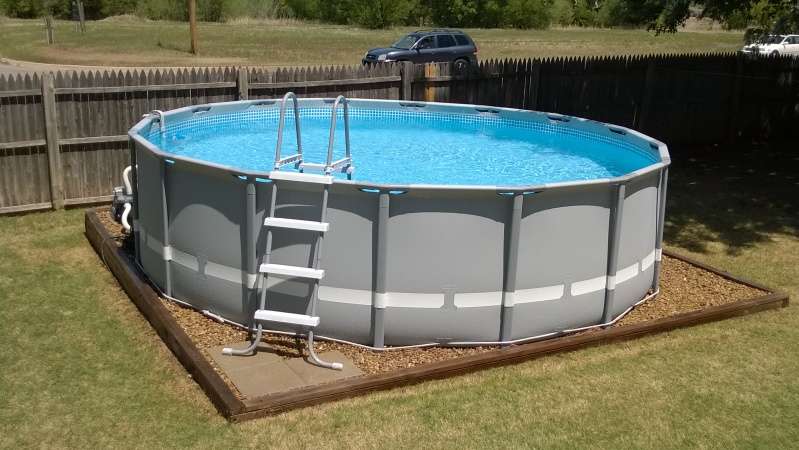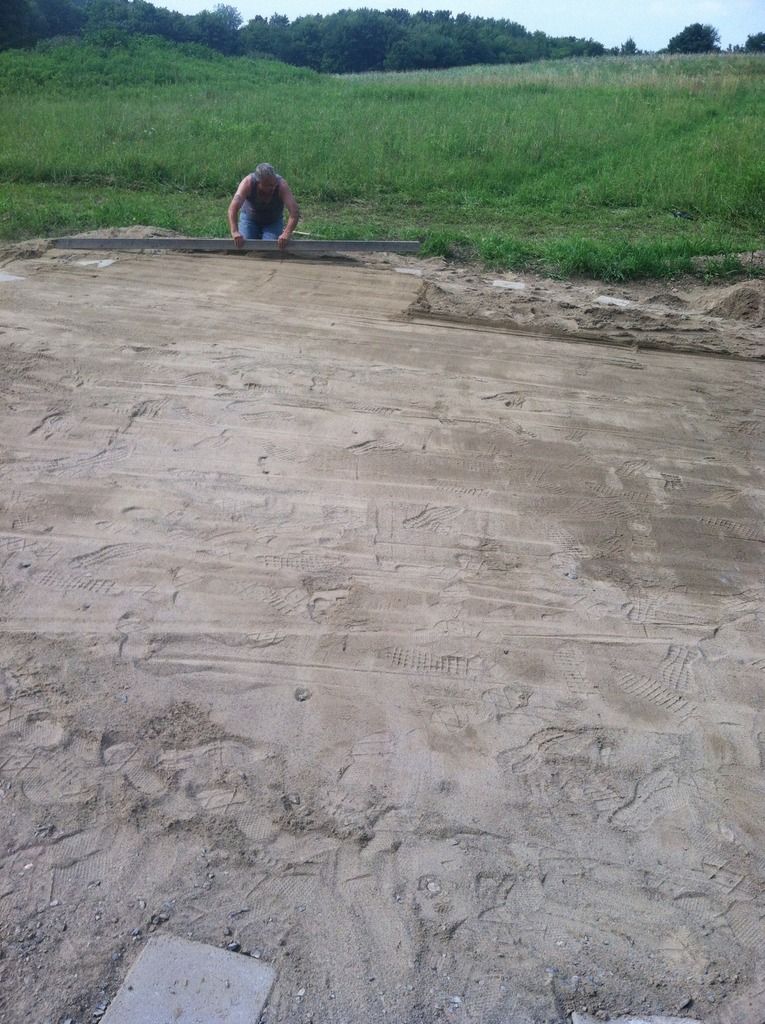Hello all! I am new to the forum and new to owning a pool. I inherited a 16'x48' Coleman pool from a friend who overheard me talking about buying one. He had it set up for a summer, filled it a bit and never used it. The pool is in decent shape. I set it up last week to get a good look at it and clean it up, then I took it down and put in in the garage. I need to patch a couple holes from where his dog tried to eat it (after it ate the cover!). I also had to order some replacement parts that were missing from the Bestway Company. I had to order a few of the feet and a new drain valve cap today, so I'm hoping they get here soon! I'm a bit nervous about receiving the correct parts from them because there was a language barrier on their end...
Last weekend, my husband and his dad used a sod cutter to get rid of the grass and then built a wooden frame out of treated 2x4's where the dirt will go and be leveled (my back yard isn't very level so we'll have to build up an area). After the dirt is leveled, we will put a tarp down, then a layer of 1 1/2" insulation foam (taped together with gorilla tape), and then topped with another tarp. This seems to be the best idea I've read online about leveling the pool and having a soft bottom for our feet.
The pool came with the standard filter, which I've read is junk. I'm sure I'll replace it eventually, but I want to try it out. I don't want to buy an expensive filter just to find out that maintaining a pool isn't for me. If I do upgrade, I plan on getting the sand filter for Intex pools (I've read that the fittings are the same size for Coleman pools).
My questions:
1. Just incase the drain valve cap doesn't actually ship, does anyone know if Coleman and Intex pools have the same size drain fittings? I can't fill the pool without the cap!
2. Which is cheapest, salt water or chlorinated tap water? If I do decide to use salt water, can the standard filter be used with it? If I do upgrade, do I need a sand filter AND the saltwater filter?
3. I have a footbath, surface skimmer, floor vacuum, thermometer and some cool toys. I plan on buying a cover after I get my replacement parts sent. Any other equipment suggestions?
4. I live in Kansas. Right now, the weather is all over the place. I had planned on setting up the pool and filling it in April, assuming the temp stays above 50 degrees over night. Is that alright or should I aim for a different temp?
5. I am going to have an electrician come out and install an outlet for the pool... really dumb question, but what exactly is this outlet called? I'm looking to do one of those stand alone outlets that are driven into the ground. After that is installed, I will put down some pavers, sit the filter on top and then build a protective wooden box around them to keep them out of the weather.
I plan on reading about pool chemistry before I set up and fill the pool, so I'll grab all the chemicals then and have them ready to go.
Thanks in advance for the help, hopefully my questions aren't too noobish.
Last weekend, my husband and his dad used a sod cutter to get rid of the grass and then built a wooden frame out of treated 2x4's where the dirt will go and be leveled (my back yard isn't very level so we'll have to build up an area). After the dirt is leveled, we will put a tarp down, then a layer of 1 1/2" insulation foam (taped together with gorilla tape), and then topped with another tarp. This seems to be the best idea I've read online about leveling the pool and having a soft bottom for our feet.
The pool came with the standard filter, which I've read is junk. I'm sure I'll replace it eventually, but I want to try it out. I don't want to buy an expensive filter just to find out that maintaining a pool isn't for me. If I do upgrade, I plan on getting the sand filter for Intex pools (I've read that the fittings are the same size for Coleman pools).
My questions:
1. Just incase the drain valve cap doesn't actually ship, does anyone know if Coleman and Intex pools have the same size drain fittings? I can't fill the pool without the cap!
2. Which is cheapest, salt water or chlorinated tap water? If I do decide to use salt water, can the standard filter be used with it? If I do upgrade, do I need a sand filter AND the saltwater filter?
3. I have a footbath, surface skimmer, floor vacuum, thermometer and some cool toys. I plan on buying a cover after I get my replacement parts sent. Any other equipment suggestions?
4. I live in Kansas. Right now, the weather is all over the place. I had planned on setting up the pool and filling it in April, assuming the temp stays above 50 degrees over night. Is that alright or should I aim for a different temp?
5. I am going to have an electrician come out and install an outlet for the pool... really dumb question, but what exactly is this outlet called? I'm looking to do one of those stand alone outlets that are driven into the ground. After that is installed, I will put down some pavers, sit the filter on top and then build a protective wooden box around them to keep them out of the weather.
I plan on reading about pool chemistry before I set up and fill the pool, so I'll grab all the chemicals then and have them ready to go.
Thanks in advance for the help, hopefully my questions aren't too noobish.


 Woo, lots of questions.
Woo, lots of questions. 
